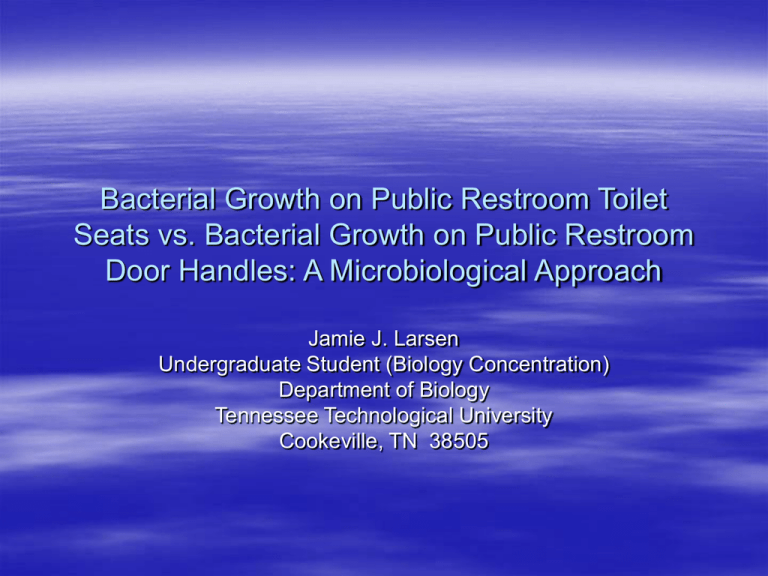Manuscript Powerpoint
advertisement

Bacterial Growth on Public Restroom Toilet Seats vs. Bacterial Growth on Public Restroom Door Handles: A Microbiological Approach Jamie J. Larsen Undergraduate Student (Biology Concentration) Department of Biology Tennessee Technological University Cookeville, TN 38505 Introduction People have come to desire information that would tell them how to disinfect particular areas (Ojima et al 2002). No one has yet used uniform sampling conditions to derive bacterial count distributions (Ojima et al 2002). Introduction (cont’d) The accumulation of this data would lead to research that could contribute to the estimation of infection risks for communicable diseases (Ojima et al 2002). Flushing of a toilet produces bacteria-laden aerosols which settle on the toilet and bathroom surfaces (Rusin et al 1998). Introduction (cont’d) Bathroom sites such as the toilet bowl surface, flush handle, and floor are often contaminated with E. coli and other coliforms due to direct transmission from flushing of the toilet (Rusin et al 1998). Many enteric pathogens are spread by the fecaloral route and it has been suggested that the fallout of droplets containing fecal material, after flushing the toilet, is an important infection hazard within the bathroom (Barker and Jones 2005). Introduction (cont’d) Another infection hazard in bathrooms is the decreased number of people who wash their hands. Handwashing is one of the most important factors in controlling the spread of bacteria and in preventing development of infections (Guinan et al 1997). Introduction (cont’d) Viruses can also be transferred due to contact with public restroom surfaces. Viruses can survive on inanimate objects, but their transfer and survival on hands also plays a part in their transmission (Bellamy et al 1998) Introduction With the data obtained from studies on bacterial growth on public restroom surfaces it would be possible to promote the general publics’ understanding of sanitation issues and facilitate the provision of useful information and products (Ojima et al 2002). Objective/Hypothesis Objective – Determine which surface contained the most bacterial growth Hypothesis – Public restroom toilet seats will contain the most bacteria Null Hypothesis – Both the toilet seats and the door handles will contain the same amount of bacteria Methods and Materials Materials (Goss 2006) – Data Form – 10 agar plates (divided in half) – Sterilized cotton swabs – Gloves – Distilled Water – Permanent Marker (to label plates) – Incubator Methods and Materials (cont’d) Methods (Goss 2006) – Swabbed toilet seats and door handles in ten public restroom sites – Cleaned one site with bathroom cleaner – Labeled/Streaked the agar plates – Incubated for 48 hours – Checked growth, did colony counts, and analyzed results using the t-test statistic (http://iweb.tntech/cabrown/Ecology%20labs/t-tests.doc) – Repeated experiment Results Even though two runs of the experiment were conducted, each produced similar results so therefore only data obtained from the first experiment was used in interpretation of the results. Sample size=9 not 10 due to too much growth on one of the plates. Results (cont’d) Table 1: Bacterial Growth Colony Counts (Run 1) Colony Counts Colony Counts Sample # Toilet Seats Door Handles 1 0 6 2 52 11 3 84 13 4 100 14 5 0 15 6 50 2 7 0 12 8 10 35 9 100 19 TOTAL 396 127 Results (cont’d) Table 2: T-test Results Toilet Seats Door Handles 44 14.1 1867 86.11 Sample Size (n) 9 9 T-test Statistic = 2.13 (2.13>2.10, reject null) Mean (X) 2 Variance (s ) Results (cont’d) Bacterial Growth Colony Counts: Toilet Seats vs. Door Handles Colony Counts 120 100 80 Toilet Seats Door Handles 60 40 20 0 1 2 3 4 5 6 7 8 9 Sample Number Figure 1: Bacterial Growth Colony Counts: Toilet Seats vs. Door Handles Results (cont’d) Figure 2: Picture of bacterial growth from one of the sites tested Results (cont’d) Figure 3: Bacterial growth at another site… Results (cont’d) Figure 4: Bacterial growth at another site… Discussion Since it was found that public restroom toilet seats contained the most bacterial growth, it seems that bacteria-laden aerosols do tend to settle more on the toilet seats rather than on the door handles. (t-test=2.13>2.10, Table 2) This then contributes to higher bacterial growth colony counts. Discussion (cont’d) Barker and Jones (2005) found that both the bacteria attached to the sidewalls and those present in the bowl water contribute to the aerosol formation. This then exemplifies the amount of bacteria-laden aerosols that settle on the surface of the toilet seat and therefore it can be easily seen why it was found that there is more bacterial growth on public restroom toilet seats. Discussion (cont’d) Another study done by Stuart and Jones (2006), in which they sampled steel push plate door handles at a University, found that while staphylococci could be isolated from some of the restroom push plates, the total numbers were very low and included no isolates of S. aureus. This shows that even though the bathrooms tested were found in an area where people regularly use them throughout the day the researchers were unable to isolate any bacteria from them. Discussion A study done by Bellamy (et al 1998) found that hemoglobin, indicating the presence of blood and therefore possible contamination of surfaces with blood-borne viruses, was found on toilet bowls and toilet seats. Bellamy (et al 1998) also goes on to say that these surfaces are frequently handled and could therefore play a part in viral transmission. Discussion (cont’d) This study agrees with the results of my study in that contact with a public restroom surface that is not thoroughly disinfected could lead to transmission of bacterial and viral infections. Discussion (cont’d) The results of my research, however, disagree with the results of Rusin (1998) in which it was determined that the toilet seat was the cleanest site tested. However, Rusin (1998) goes on to say that this may be due to regular disinfection of the toilet and therefore results in lower levels of bacterial growth. Discussion (cont’d) Another study that disagrees with my findings is a study done by Ojima (et al 2002) in which they found that coliforms and E. coli were not found on toilet bowl rims and that the contamination level for toilets was the lowest of the study. Ojima (et al 2002) goes on to say that this could also be due to regular disinfection at the sites tested. Conclusions Reject null hypothesis – T-test=2.13>2.10 (Table 2) Accept hypothesis There is more bacterial growth on public restroom toilet seats than on public restroom door handles. Bacteria-laden aerosols do contribute to the increased amount of bacteria found on the toilet seats. Conclusions Bacteria-laden aerosols tend to settle more on the toilet seat rather than on the restroom door handles. I hope that more studies can be done on the amount of bacterial growth on environmental surfaces. Conclusions I think a good area of research would be on, not only the amount of bacteria found on public restroom surfaces, but also the types of bacteria found on public restroom surfaces. I would also recommend research to be done on exactly what types of bacteria found on public restroom surfaces are problematic. Conclusions I hope that the results of this experiment help to educate the public about the amount of bacteria found in public restrooms. I believe that by knowing this information, people will become better aware of their surroundings and improve their personal hygiene in public restrooms. ??Any Questions??








